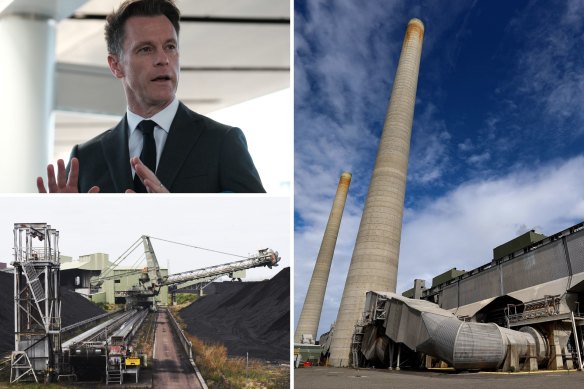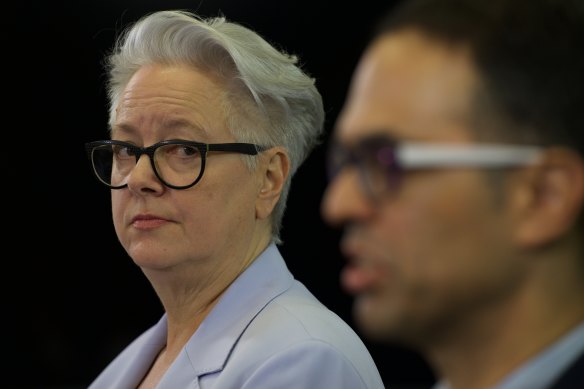By Alexandra Smith and Michael McGowan
The Minns government will pay Origin Energy up to $450 million over the next two years to extend the life of Australia’s largest coal-fired power station, Eraring, should the company opt in to a deal that NSW Treasurer Daniel Mookhey insisted was “not an act of corporate welfare”.
Under the terms of the agreement announced on Thursday, the NSW government will not make any upfront payment to Origin, but will enter into what Mookhey called a “risk-sharing” arrangement if Origin agrees.

The Minns government says taxpayers are protected by its Eraring deal.
Taxpayers would share 20 per cent of any profit Eraring makes during the life of the agreement, but that share is capped at $40 million. If the plant loses money, taxpayers will underwrite 80 per cent of those losses capped at $225 million a year.
Origin will decide by March 31, 2025, and 2026 whether it signs up to a risk-sharing arrangement for the following financial year.
Since coming to power last year the NSW government has flagged that it was negotiating with Origin to extend Eraring beyond its 2025 closure date because of concern about a forecast energy reliability gap.
But some experts, including many from the renewable energy sector, have criticised the government for agreeing to a deal they say is unnecessary. Tim Buckley, the head of pro-renewables think tank Clean Energy Finance, labelled it “yet another massive coal subsidy funded by electricity users in NSW”.

NSW Environment and Energy Minister Penny Sharpe and NSW Treasurer Daniel Mookhey have announced that the operating life of Eraring power station will be extended for two years.Credit: Nick Moir
Announcing the deal, Energy Minister Penny Sharpe dismissed those criticisms, pointing to a recent 10-year forecast by the Australian Energy Market Operator, which pointed to increased risk of black-outs in NSW due to slower than expected rollout of some renewable projects.
“It is challenging; we are having to manage what’s going out with what’s going in. And I don’t think any sensible government would accept that you roll the dice and just suggest that it’ll be right, mate. Because it’s not going to be,” she said.
Under the two-year agreement, Eraring must generate at least six terawatt-hours each year, the equivalent to the typical annual output of two of Eraring’s four generating units and enough to resolve the forecast reliability gap.
Eraring must also maintain its workforce of about 220 people, commit to a maintenance plan and adhere to its licence conditions, which include environmental protections.
Mookhey conceded he would have preferred not to be in a position to strike the deal, and criticised the former government for its decision to sell Eraring to Origin in 2013.
But, he insisted, the deal struck the right balance.
“This is a finely calibrated risk-sharing arrangement. It’s not an act of corporate welfare on the part of the government. But nor is it an act of charity on the part of Origin Energy,” he said.
Origin now expects to close Eraring on August 19, 2027.
Premier Chris Minns said he made an election commitment that Labor would extend the life of Eraring if required to “keep the lights on in NSW”.
“The people of NSW now have certainty that the NSW government has a plan to ensure we have reliable energy while we transition the workforce and the economy to net zero,” Minns said.
“The best way to undermine the renewable energy transition is to have the lights go out in 2025. I’m not letting that happen.”
The agreement will be tabled in parliament in the next sitting week to ensure transparency.
Origin chief executive Frank Calabria said the company believed the agreement struck the right balance, enabling Eraring to continue supporting the security of electricity supply in NSW through the energy transition while making compensation available to Origin if economic conditions for the plant are challenging.
“This agreement supports Eraring to continue to play an important role in maintaining reliable power for businesses and households through a period in which there remains considerable uncertainty about the volume and timing of new renewables, transmission and firming infrastructure coming online,” Calabria said.
“Importantly, today we can give our Eraring employees, our suppliers and the local community greater certainty around the future of the plant as we transition towards its retirement.”
The prospect of using taxpayers’ money to extend the life of Eraring puts the NSW government on course for a clash with renewable energy advocates and climate campaigners. Coal is a dominant source of greenhouse gas emissions that the world must phase out to help avert catastrophic global warming.
“There is no way Australia can meet its renewable and climate targets if we keep propping up coal-fired power stations, particularly the nation’s biggest,” said Wayne Smith, acting chief executive of the Smart Energy Council, which represents solar and battery installers.
However, with at least half of the remaining 14 coal generators on the eastern seaboard due to close within the next decade, governments are becoming increasingly nervous that not enough new renewable energy generators, storage projects and transmission lines are being built to keep power supplies and prices stable.
The Victorian government has already intervened to ensure two of its biggest coal generators do not shut prematurely.
“Australia’s great energy transition – from fossil fuels to renewables – is not going well,” said Tony Wood, energy director at research organisation the Grattan Institute.
In a report published last month, Wood foreshadowed that NSW would need to prop up Eraring until the grid was equipped to handle its withdrawal, and may also have to cut a deal to support the Bayswater coal generator.
With Nick Toscano, Mike Foley
Start the day with a summary of the day’s most important and interesting stories, analysis and insights. Sign up for our Morning Edition newsletter.